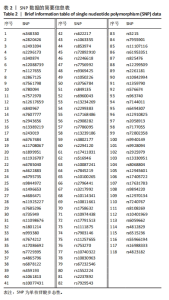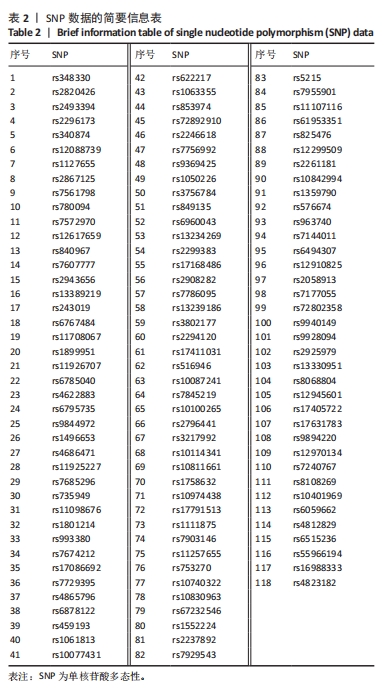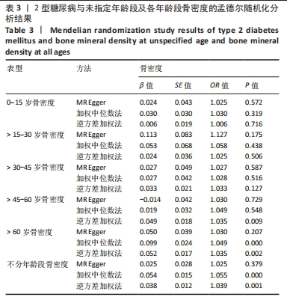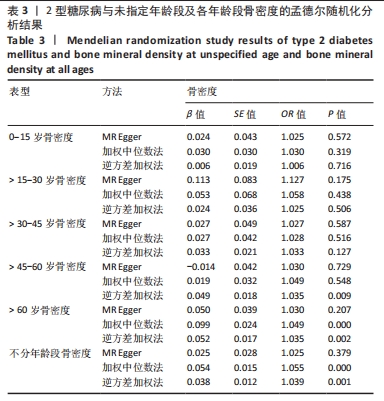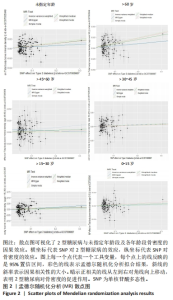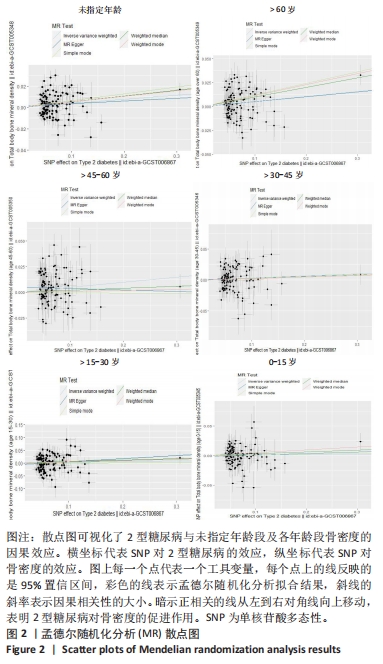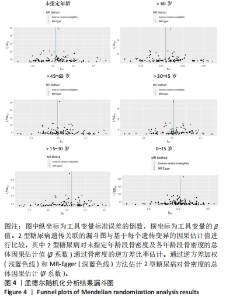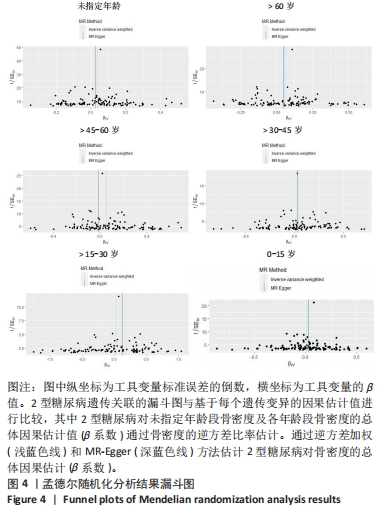Chinese Journal of Tissue Engineering Research ›› 2024, Vol. 28 ›› Issue (35): 5662-5668.doi: 10.12307/2024.575
Previous Articles Next Articles
Effect of type 2 diabetes mellitus on bone mineral density in different age groups: a two-sample Mendelian randomization study
Huang Wenzhuo1, Xiang Haizhu1, Ma Weiwei1, Huang Xin1, Fu Hongjun2, Xiong Yong1
- 1Hubei University of Chinese Medicine, Wuhan 430061, Hubei Province, China; 2Xiangyang Hospital of Traditional Chinese Medicine, Xiangyang 441001, Hubei Province, China
-
Received:2023-10-28Accepted:2023-12-02Online:2024-12-18Published:2024-03-15 -
Contact:Fu Hongjun, Master, Associate chief physician, Xiangyang Hospital of Traditional Chinese Medicine, Xiangyang 441001, Hubei Province, China Xiong Yong, MD, Associate professor, Associate chief physician, Master’s supervisor, Hubei University of Chinese Medicine, Wuhan 430061, Hubei Province, China -
About author:Huang Wenzhuo, Master candidate, Hubei University of Chinese Medicine, Wuhan 430061, Hubei Province, China Xiang Haizhu, Master candidate, Hubei University of Chinese Medicine, Wuhan 430061, Hubei Province, China
CLC Number:
Cite this article
Huang Wenzhuo, Xiang Haizhu, Ma Weiwei, Huang Xin, Fu Hongjun, Xiong Yong. Effect of type 2 diabetes mellitus on bone mineral density in different age groups: a two-sample Mendelian randomization study[J]. Chinese Journal of Tissue Engineering Research, 2024, 28(35): 5662-5668.
share this article
Add to citation manager EndNote|Reference Manager|ProCite|BibTeX|RefWorks
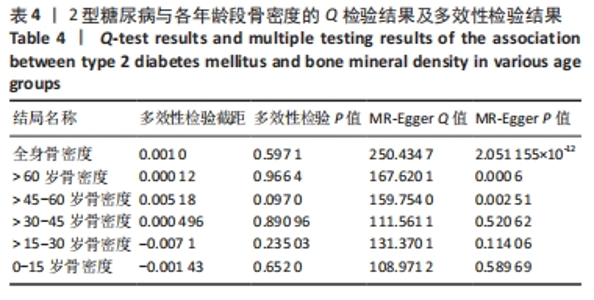
2.3 敏感度分析结果 留一分析显示2型糖尿病与骨密度之间的联系不是单一SNPs所主导的,敏感性分析结果显示在逐一排除法中未发现对因果关联估计值影响较大的 SNPs。2型糖尿病与未指定年龄段及各年龄段骨密度留一图见图3。其中2型糖尿病与未指定年龄段骨密度的Cochran’s Q检验结果如下:逆方差加权法分析(Q=251.057 3,P=2.589 068×10-12);MR-Egger分析(Q=250.434 7,P=2.051 155×10-12),2型糖尿病与各年龄段骨密度的Q检验结果及多效性检验结果见表4。结果表明,2型糖尿病与未指定年龄段骨密度以及45岁以上年龄段骨密度的SNP间存在异质性,2型糖尿病与未指定年龄段骨密度以及各年龄段骨密度的SNP间均不存在水平多效性,因此关注随机效应逆方差加权法模型。漏斗图结果显示当某一SNP作为工具变量时,其表示因果关联效应的点对称分布,结果表明因果联系受到潜在偏倚影响较小,详见图4。基于以上分析,MR-Egger回归结果不具有水平多效性,提示逆方差加权法分析的结果可作为因果关系的主要标准,因此可以得出2型糖尿病可能是骨密度的保护性因素之一,其相关性可能与年龄相关。"
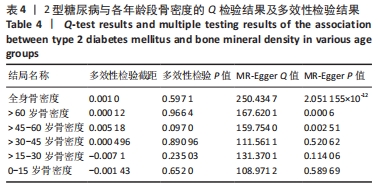
| [1] CHANG X, XU S, ZHANG H. Regulation of bone health through physical exercise: Mechanisms and types. Front Endocrinol (Lausanne). 2022;13:1029475. [2] 《中国骨质疏松杂志》骨代谢专家组.骨代谢生化指标临床应用专家共识(2023修订版)[J].中国骨质疏松杂志,2023,29(04):469-476. [3] WANG L, YU W, YIN X, et al. Prevalence of Osteoporosis and Fracture in China: The China Osteoporosis Prevalence Study. JAMA Netw Open. 2021;4(8):e2121106. [4] 周凤云,耿健,程晓光.能量CT定量测量骨密度和骨髓脂肪的研究现状[J].中国骨质疏松杂志,2023,29(8):1215-1219. [5] 张丽雯,阮梅花,刘加兰,等.糖尿病领域研发态势分析[J].遗传,2022,44(10): 824-839. [6] KANIS JA, JOHANSSON H, MCCLOSKEY EV, et al. Previous fracture and subsequent fracture risk: a meta-analysis to update FRAX. Osteoporos Int. 2023;34(12): 2027-2045. [7] 邓霞,秦慧娟,陈珂,等.2型糖尿病患者血清Metrnl水平与骨密度的相关性研究[J].中国骨质疏松杂志,2023,29(6):812-817+824. [8] LIU J, TANG Y, PENG B, et al. Bone mineral density is associated with composite dietary antioxidant index among US adults: results from NHANES. Osteoporos Int. 2023;34(12):2101-2110. [9] BOWDEN J, HOLMES MV. Meta-analysis and Mendelian randomization: A review. Res Synth Methods. 2019;10(4):486-496. [10] LI B, QU Y, FAN Z, et al. Causal relationships between blood lipids and major psychiatric disorders: Univariable and multivariable mendelian randomization analysis. BMC Med Genomics. 2023;16(1):250. [11] SHAPLAND CY, ZHAO Q, BOWDEN J. Profile-likelihood Bayesian model averaging for two-sample summary data Mendelian randomization in the presence of horizontal pleiotropy. Stat Med. 2022;41(6):1100-1119. [12] BURGESS S, SCOTT RA, TIMPSON NJ, et al. EPIC- InterAct Consortium. Using published data in Mendelian randomization: a blueprint for efficient identification of causal risk factors. Eur J Epidemiol. 2015;30(7):543-552. [13] TACHMAZIDOU I, HATZIKOTOULAS K, SOUTHAM L, et al. Identification of new therapeutic targets for osteoarthritis through genome-wide analyses of UK Biobank data. Nat Genet. 2019;51(2):230-236. [14] YENGO L, SIDORENKO J, KEMPER KE, et al. GIANT Consortium. Meta-analysis of genome-wide association studies for height and body mass index in -700000 individuals of European ancestry. Hum Mol Genet. 2018;27(20):3641-3649. [15] ZHANG H, LIU L, NI JJ, et al. Pleiotropic loci underlying bone mineral density and bone size identified by a bivariate genome-wide association analysis. Osteoporos Int. 2020;31(9):1691-1701. [16] SKRIVANKOVA VW, RICHMOND RC, WOOLF BAR, et al. Strengthening the reporting of observational studies in epidemiology using mendelian randomisation (STROBE-MR): explanation and elaboration. BMJ. 2021;375:n2233. [17] SUN K, GAO Y, WU H, et al. The causal relationship between gut microbiota and type 2 diabetes: a two-sample Mendelian randomized study. Front Public Health. 2023;11:1255059. [18] LIN Z, DENG Y, PAN W. Combining the strengths of inverse-variance weighting and Egger regression in Mendelian randomization using a mixture of regressions model. PLoS Genet. 2021;17(11):e1009922. [19] LIN L, LUO P, YANG M,et al. Causal relationship between osteoporosis and osteoarthritis: A two-sample Mendelian randomized study. Front Endocrinol (Lausanne). 2022;13:1011246. [20] BOWDEN J, DAVEY SMITH G, HAXCOCK PC, et al. Consistent Estimation in Mendelian Randomization with Some Invalid Instruments Using a Weighted Median Estimator. Genet Epidemiol. 2016;40(4):304-314. [21] 杨晓波.青年2型糖尿病危险因素研究进展[J].中国医学创新,2022,19(14): 175-179. [22] 厉姝岑.青年2型糖尿病患者糖尿病痛苦影响因素及中介效应分析[D].南京:南京中医药大学,2021. [23] ROSENBERG JL, WOOLLEY W, ELNUNU I, et al. Effect of non-enzymatic glycation on collagen nanoscale mechanisms in diabetic and age-related bone fragility. Biocell. 2023;47(7):1651-1659. [24] ALI D, TENCEROVA M, FIGEAC F, et al. The pathophysiology of osteoporosis in obesity and type 2 diabetes in aging women and men: The mechanisms and roles of increased bone marrow adiposity. Front Endocrinol (Lausanne). 2022;13: 981487. [25] 曹岚,李志强,师咏勇,等.端粒长度与2型糖尿病:孟德尔随机化研究与多基因风险评分分析[J].遗传,2020,42(9):882-888. [26] WU F, HUANG Y, HU J, et al. Mendelian randomization study of telomere length and bone mineral density. Aging (Albany NY). 2020;13(2):2015-2030. [27] 周昊龙. 2型糖尿病及相关指标对BMD的影响及因果推断研究[D].武汉:华中科技大学,2021. [28] 陈玉华,郑标,成迪,等.线粒体自噬影响胰岛素抵抗的作用及机制[J/OL].生物化学与生物物理进展,1-14[2023-11-23]. doi: 10.16476/j.pibb.2023.0205 [29] PAN L, ZOU H, MENG X, et al. Predictive values of metabolic score for insulin resistance on risk of major adverse cardiovascular events and comparison with other insulin resistance indices among Chinese with and without diabetes mellitus: Results from the 4C cohort study. J Diabetes Investig. 2023;14(8): 961-972. [30] CHEN ZH, ZHOU TF, BU YT, et al. Bone mineral density saturation as influenced by the visceral adiposity index in adults older than 20 years: a population-based study. Lipids Health Dis. 2023;22(1):170. [31] LEE S, KIM JH, JEON YK, et al. Effect of adipokine and ghrelin levels on BMD and fracture risk: an updated systematic review and meta-analysis. Front Endocrinol (Lausanne). 2023;14:1044039. [32] 向倩如,邓学健,陈华锋,等.基因修饰干细胞治疗骨质疏松:临床前研究的Meta分析[J].中国组织工程研究,2022,26(31):5053-5061. [33] 续晓蓓,郭雪桃,王叶叶,等.不同年龄段的早发性卵巢功能不全患者进行激素替代治疗对骨密度疗效的比较[J].实用药物与临床,2023,26(10):888-892. [34] LIU B, LIU J, PAN J, et al. The association of diabetes status and bone mineral density among US adults: evidence from NHANES 2005-2018. BMC Endocr Disord. 2023;23(1):27. [35] BATHINA S, ARMAMENTO-VILLAREAL R. The complex pathophysiology of bone fragility in obesity and type 2 diabetes mellitus: therapeutic targets to promote osteogenesis. Front Endocrinol (Lausanne). 2023;14:1168687. [36] HUANG G, CHEN X, CHEN Y, et al. Causal relationship between type 2 diabetes mellitus and bone mineral density: a Mendelian randomization study in an East Asian population. Osteoporos Int. 2023;34(10):1719-1727. [37] KIM MW, HUH JW, NOH YM, et al. Exploring the Paradox of Bone Mineral Density in Type 2 Diabetes: A Comparative Study Using Opportunistic Chest CT Texture Analysis and DXA. Diagnostics (Basel). 2023;13(17):2784. [38] DEDEOĞLU N, EŞER G, ÇELIK ÖZEN D, et al. Five-year change of panoramic radiomorphometric indices and fractal dimension values in type 2 diabetes patients. Oral Radiol. 2024;40(1):49-57. [39] HU Z, MA C, LIANG Y, et al. Osteoclasts in bone regeneration under type 2 diabetes mellitus. Acta Biomater. 2019;84:402-413. [40] HWANG J, YOO JA, YOON H, et al. The Role of Leptin in the Association between Obesity and Psoriasis. Biomol Ther (Seoul). 2021;29(1):11-21. [41] BHANSALI S, BHANSALI A, DUTTA P, et al. Metformin upregulates mitophagy in patients with T2DM: A randomized placebo-controlled study. J Cell Mol Med. 2020;24(5):2832-2846. [42] 韦婷婷. 胰高血糖素样肽1受体激动剂对2型糖尿病患者骨代谢影响的Meta分析[D].银川:宁夏医科大学,2022. [43] 查涛,高梅红,王松华.利拉鲁肽对糖尿病骨质疏松症大鼠骨密度和胰岛素抵抗的影响[J].中国临床药理学杂志,2023,39(18):2659-2663. [44] SASSI F, BUONDONNO I, LUPPI C, et al. Type 2 diabetes affects bone cells precursors and bone turnover. BMC Endocr Disord. 2018;18(1):55. |
| [1] | Yang Cekai, Cai Zhuoyan, Chen Ming, Liu Hao, Weng Rui, Cui Jianchao, Zhang Shuncong, Yao Zhensong. Relationship between degeneration of paraspinal muscle and refractures in postmenopausal women treated by percutaneous vertebroplasty [J]. Chinese Journal of Tissue Engineering Research, 2024, 28(9): 1414-1419. |
| [2] | Xiaheida·Yilaerjiang, Nijiati·Tuerxun, Reyila·Kuerban, Baibujiafu·Yelisi, Chen Xin. Three-dimensional finite element analysis of the distribution pattern of stress in bone tissues with different characteristics [J]. Chinese Journal of Tissue Engineering Research, 2024, 28(8): 1277-1282. |
| [3] | Kaiyisaier•Abudukelimu, Maimaitimin•Abulimiti, Li Lei, Yang Xiaokai, Zhang Yukun, Liu Shuai. Effect of lumbar CT values in the diagnosis of osteoporosis in women patients with lumbar degenerative diseases [J]. Chinese Journal of Tissue Engineering Research, 2024, 28(6): 945-949. |
| [4] | Wang Liping, Lian Tianxing, Hu Yongrong, Yang Hongsheng, Zeng Zhimou, Liu Hao, Qu Bo. HU value of chest CT vertebral body in the opportunistic screening of type 2 diabetes mellitus osteoporosis [J]. Chinese Journal of Tissue Engineering Research, 2024, 28(6): 950-954. |
| [5] | Abuduwupuer·Haibier, Alimujiang·Yusufu, Maihemuti·Yakufu, Maimaitimin·Abulimiti, Tuerhongjiang·Abudurexiti. Meta-analysis of efficacy and safety of terlipatide and bisphosphate in the treatment of postmenopausal osteoporosis fractures [J]. Chinese Journal of Tissue Engineering Research, 2024, 28(4): 639-645. |
| [6] | Liu Dongyuan, Guan Haishan, Shi Haoran, Liu Xiaoliang, Zhou Haosheng. Risk factors for adjacent vertebral compression fractures after percutaneous vertebroplasty [J]. Chinese Journal of Tissue Engineering Research, 2024, 28(36): 5884-5891. |
| [7] | Yang Jingyan, Ma She, Huang Renjun, Wang Chaoyi, Zhao Yuyang, Yu Dong. Causal relationship between trunk and lower limb fat mass and intervertebral disc degeneration based on a Mendelian randomization analysis [J]. Chinese Journal of Tissue Engineering Research, 2024, 28(35): 5688-5694. |
| [8] | Li Wei, Chai Jinlian, Jia Haifeng, Li Hanzheng, Sun Tiefeng, Liang Xuezhen. Causal association of micronutrients with osteonecrosis: evidence from a bidirectional Mendelian randomization trial [J]. Chinese Journal of Tissue Engineering Research, 2024, 28(33): 5308-5314. |
| [9] | Liu Yi, Liu Yuan, Liu Jinbao, Li Nianhu, Zhu Weiming, Xu Bo. Causal effects of serum trace elements and nutrients on osteonecrosis: a Mendelian randomization analysis [J]. Chinese Journal of Tissue Engineering Research, 2024, 28(33): 5326-5332. |
| [10] | Chen Jixin, Yu Weijie, Guo Tianci, Zhou Qinxin, Niu Puyu, Ye Yuntian, Liu Aifeng. Sleep characteristics and risk of osteoarthritis: a two-sample and multivariate Mendelian randomization study [J]. Chinese Journal of Tissue Engineering Research, 2024, 28(32): 5203-5209. |
| [11] | Chen Tianxin, Dong Tingting, Li Yan, Zhang Sheng, Zhang Lei. Causal relationship between blood metabolites and sarcopenia-related traits: a Mendelian randomization study [J]. Chinese Journal of Tissue Engineering Research, 2024, 28(27): 4288-4292. |
| [12] | Fan Yidong, Qin Gang, He Kaiyi, Gong Yufang, Li Weicai, Wu Guangtao. Expression of immune-related genes in rheumatoid arthritis and a two-sample Mendelian randomization study of immune cells [J]. Chinese Journal of Tissue Engineering Research, 2024, 28(27): 4312-4318. |
| [13] | Zhan Qunzhang, Zhang Yuling, Han Yuxin, Lyu Jiazhen, Zheng Xiaoxia, Qu Chongzheng. Association between obesity and osteoporosis: a two-sample Mendelian randomization analysis [J]. Chinese Journal of Tissue Engineering Research, 2024, 28(27): 4319-4324. |
| [14] | Chai Jinlian, Li Shudong, Li Wei, Du Haitao, Dong Limin, Liang Xuezhen, Wang Ping. Gut microbiota and drug-associated osteonecrosis: a two‑sample Mendelian randomization study [J]. Chinese Journal of Tissue Engineering Research, 2024, 28(27): 4325-4331. |
| [15] | Ma Weiwei, Xiong Yong, Chen Honggu, Huang Wenzhuo, Huang Xin, Zhou Xiaohong. Relationship between statin drugs and bone density: a drug target-mediated Mendelian randomization study [J]. Chinese Journal of Tissue Engineering Research, 2024, 28(27): 4340-4345. |
| Viewed | ||||||
|
Full text |
|
|||||
|
Abstract |
|
|||||
